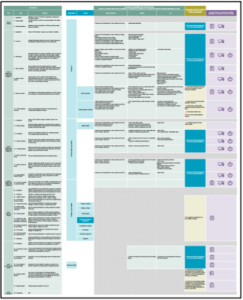Release of COLREGs Operator Guidance Framework
By Rachel Horne, Assurance of Autonomy Activity Lead, TAS
TAS and Frazer-Nash Consultancy have developed a COLREGs Operator Guidance Framework to make it easier to understand and comply with International Regulations for Preventing Collisions at Sea (COLREGs) when operating autonomous and remotely operated vessels. This Framework is available for standalone use, or as an annex to the new Australian Code of Practice for the Design, Construction, Survey and Operation of Autonomous and Remotely Operated Vessels.
The COLREGs Operator Guidance Framework translates the stated and unstated capabilities described, and the terminology used, in COLREGs into a vocabulary and format that makes sense for autonomous and remotely operated vessels. It is intended to be an enabling framework to:
- Help vessel designers understand what capabilities COLREGs requires vessels to have;
- Help operators understand what capabilities COLREGs requires and how mission planning can mitigate or remove the need for solving some of the more complex elements of COLREGs; and
- Help regulators apply a consistent methodology for assessing the capability of a vessel with regards to COLREGs.

The COLREGs framework
Download the COLREGs Operator Guidance Framework on the TAS website
The intent is that the information gathered using the COLREGs Operator Guidance Framework will be used to inform regulatory approval processes and operational planning.
The COLREGs Operator Guidance Framework is currently presented as a PDF, which is best used printed in A3. It is also being converted to a digital tool in a collaboration between TAS, Frazer-Nash, and Aginic over the coming months.
Using the COLREGs Operator Guidance Framework
The recommended use of the COLREGs Operator Guidance Framework for an operator with a specific vessel and proposed operation in mind is as follows:
- Download and print out the COLREGs Operator Guidance Framework in A3 colour
- Download and fill out the Design Record Template, to ensure you have documented the capabilities of your vessel
- With your vessel particulars and the details of your proposed operation in mind, review the framework document, reading from left to right, and identify:
- When each rule in COLREGs applies (i.e. some only apply in specific contexts like when in Narrow Channels)
- The capabilities required to comply with each specific rule, broken down into the categories of Sense and Perceive, Decide, and Act (noting that these could be in the vessel, the control centre, or a combination)
- Mission constraints that could be implemented if you don’t have the capabilities to comply with a specific rule, to remain in compliance (for example, if you don’t have the capabilities needed to comply with Rule 9 – Narrow Channels, you may plan to avoid narrow channels, and therefore remain in compliance with COLREGs)
- The suitable method of compliance for each rule (for example, for Rule 5 – Lookout, the proposed evidence of compliance is Design Checklist and Simulation)
- Review your analysis, and prepare for own records a list of applicable rules for your vessel and proposed operation, corresponding required capabilities, any operational limitations that need to be imposed, and the recommended evidence type. You may then wish to provide your filled out Design Record and your analysis against the COLREGs Operator Guidance Framework to AMSA to support your application for exemption and/or certification. You can also review it when conducting operational planning to ensure you remain COLREGs compliant.
Further guidance materials, examples, and an instructional video will be released to support the use of the COLREGs Operator Guidance Framework in the coming months.
Further information
Background information on the project to develop the COLREGs Operator Guidance Framework, including the process the team used, is made available in a Briefing Note prepared by Frazer-Nash.
Next steps
TAS will be working with Frazer-Nash and Aginic to develop a digital version of the COLREGs Operator Guidance Framework. TAS intends to make this digital version available through RAS-GATEWAY, a new online portal for assurance and accreditation information and support for autonomous and remotely operated vessels.
The TAS RAS-Gateway project is creating a digital hub to support the Australian autonomous systems sector, including operators and the testing and evaluation ecosystem. The Gateway will feature new methods, policies, practices, and expertise to support accreditation. It aims to address issues currently experienced by regulators, insurers, and technology developers by, for instance, filling gaps in standards and producing consistent (yet flexible) parameters for safe and trusted operations and improved agility to meet fast-changing technical and social licence needs.
In parallel with this digital development, the COLREGs Operator Guidance Framework will be tested through a trial at the Reefworks testing range in Townsville later in 2022.
TAS welcomes feedback on the COLREGs Operator Guidance Framework to info@tasdcrc.com.au
TAS would like to thank all parties who contributed to the development of the COLREGs Operator Guidance Framework, including particularly Rob Dickie, Marceline Overduin and Andrejs Jaudzems of Frazer-Nash Consultancy for their smarts and creativity in identifying the best way to turn an idea into a tangible enabling framework, and then doing the hard analytical, excel, and design work to make it happen.
This project received funding support from the Queensland Government through Trusted Autonomous Systems (TAS), a Defence Cooperative Research Centre funded through the Commonwealth Next Generation Technologies Fund and the Queensland Government.





